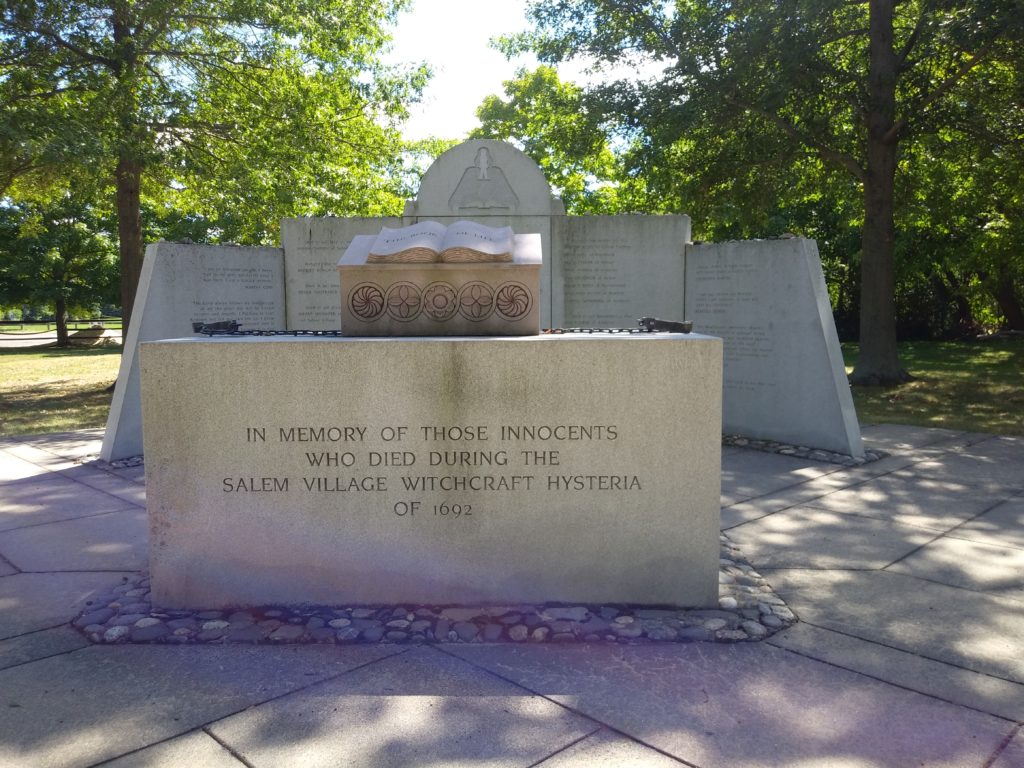I’ve been working on a new project about how New England memorialized seventeenth-century witch trials during the twentieth century, and recently presented some of this research at the fall New England Historical Association virtual conference.
By my count, there are at least a dozen memorials in New England dedicated to people who were accused, convicted, or executed for witchcraft. It will surprise no one to learn that the majority of these monuments in New England are related to the Salem witch trials of 1692, during which about 200 were accused and twenty-five people died. Currently there are witchcraft memorials in Connecticut, Massachusetts, and New Hampshire. There are also what we might call unofficial monuments to witches in place names throughout New England. For example, there is a Witch Creek (aka Witch Cove) in Portsmouth, New Hampshire that still appears on USGS maps.
The earliest memorials in New England are connected to the Salem witch trials, and they were established by descendants of people who were executed in 1692. This includes the granite obelisk dedicated to Rebecca Nurse in 1885 in Danvers, Massachusetts and the John Proctor Memorial dedicated in 1902 in Peabody, Massachusetts. These earliest monuments were based on the desire to restore family honor, and to impact public memory by making a clear point that an ancestor accused and executed for witchcraft at Salem was innocent.
A rather different case is that of Eunice Cole. In 1938, Hampton, New Hampshire residents voted to exonerate and create a memorial for Cole, a local woman who had been accused of witchcraft by her neighbors repeatedly for more than two decades during the seventeenth century. As part of the town of Hampton’s 300th anniversary celebration, the town voted to exonerate her. Hampton declared August 25, 1938 “Goody Cole Day” and held a pageant that reenacted and dramatized the events of her trials.
However, the town did not actually install the memorial at that time (although newspaper reports said they were going to put up a tablet). A boulder was placed on the town green twenty-five years later in 1963 near where Cole lived while she was a ward of the town. The boulder was installed without a plaque or any marker during a ceremony as part of the town’s 325th celebration. Fifty years after that, a plaque was placed in front of the boulder as part of Hampton’s 375th celebration in 2013. Her reputation in public memory changed significantly over time; she was reviled by her community during her lifetime, but by the twentieth century she was characterized as a tragic, misunderstood figure rather than a scold and a menace.
Two memorials to the victims of the Salem witch trials were created in 1992 in Salem and Danvers. 1992 was the tercentenary of the Salem witch trials, and it was an anniversary that generated a remarkable amount of new attention and new scholarship on the history of witchcraft in New England. Most recently, the Proctor’s Ledge Memorial was dedicated by the city of Salem on July 19, 2017—it is a subtle design on a quiet street located outside of the tourist district.
In these examples and others, modern concerns motivated communities to create public memorials centuries after the events took place. By examining these representations of witch trials in public memory, we can see not only how ideas about witchcraft have changed over time, but also ideas about commemoration, justice, family legacies, and the responsibilities of communities that have been historical sites of violence.
Despite Hampton’s efforts to generate tourism in the 1930s, very few people today visit the Eunice Cole Memorial, while hundreds of thousands will walk through downtown Salem’s 1992 memorial each year. Yet it was only in 2017 that the execution site was commemorated at Proctor’s Ledge. And in Bridgeport, Connecticut, a new memorial was just dedicated in 2019 to a woman executed in 1653. As these recent efforts to create new monuments show, New England’s work of commemorating the witch trials is far from over.

Resources:
Rebecca Nurse memorial: William P Upham, “Account of the Rebecca Nurse Monument” in Essex Institute Historical Collections vol. XXIII (Salem, MA: Essex Institute, 1886): 151-160. https://hdl.handle.net/2027/osu.32435069736700?urlappend=%3Bseq=163
Danvers 1992 memorial: http://salem.lib.virginia.edu/Commemoration.html
Hampton: http://www.hampton.lib.nh.us/hampton/biog/goody.htm
Salem: Judith Wasserman, “Retail or Re-tell?: The Case of the Salem Tercentenary Memorial” Landscape Journal 22.1 (2003): 1-11 and Dane Morrison and Nancy Schultz, eds., Salem: Place, Myth, and Memory (Northeastern University Press, 2004).
Proctor memorial: https://salemwitchmuseum.com/locations/john-proctor-house/
